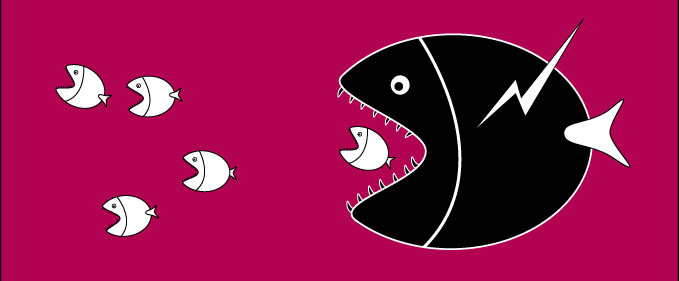Is cannibalization good or bad?
 In globalized markets successful innovation has become a key driver for revenue growth, competitive margins and, in some cases, even for survival of the business. The ability to bring innovation to market swiftly, efficiently and ahead of competitors is becoming ever more significant. An efficient product launch requires incorporating great workable strategies and coordination among multiple functional areas, including product design, procurement, planning, manufacturing process, sales and marketing. In addition, as organizations increasingly leverage core capabilities of other companies, innovation has to be delivered through virtual networks, working with partners in a collaborative environment to bring product and services to market faster, smarter and cheaper. Today’s markets are swiftly altering leaving no room to even think. Cannibalization is a glaring reality and it’s better to accept and survive with it. The CEO of Apple Inc, Tim Cook says “Better to eat your own than have your own eaten by others”. That’s Apple’s philosophy on product cannibalization.
In globalized markets successful innovation has become a key driver for revenue growth, competitive margins and, in some cases, even for survival of the business. The ability to bring innovation to market swiftly, efficiently and ahead of competitors is becoming ever more significant. An efficient product launch requires incorporating great workable strategies and coordination among multiple functional areas, including product design, procurement, planning, manufacturing process, sales and marketing. In addition, as organizations increasingly leverage core capabilities of other companies, innovation has to be delivered through virtual networks, working with partners in a collaborative environment to bring product and services to market faster, smarter and cheaper. Today’s markets are swiftly altering leaving no room to even think. Cannibalization is a glaring reality and it’s better to accept and survive with it. The CEO of Apple Inc, Tim Cook says “Better to eat your own than have your own eaten by others”. That’s Apple’s philosophy on product cannibalization.
Market cannibalization refers to a situation where a new product “eats” up the sales and demand of an existing product. This can negatively affect both the sales volume and market share of the existing product. Market cannibalization occurs when a new product encroaches on the existing market for the older product, rather than expanding the company’s market base. Rather than attracting a new segment of the market and increasing market share, the new product appeals to the company’s current market, resulting in reduced sales and market share for the existing product.
Creative destruction cannot be avoided. When Joseph Schumpeter coined this term in 1942, he was damn sure that the future is all about impatient, over competitive ‘destructive creation’. Though, Schumpeter’s idea of creative destruction was as the renewing of society through cycle of innovations, which would lead into higher levels of economic development and welfare. He also mentioned then that creative destruction would create discomfort and loss to the existing players while newcomers would benefit and increase value creation for broader society.
Organizations now not only need to integrate internally, but also externally with suppliers and customers, creating end-to-end supply chain processes and capabilities which differentiate on product and customer requirements. Successful innovation is of tremendous benefit to the organization while launching a new product. If the company can launch the product early in the market, it leads to the chance to acquire greater market share in introduction and growing phase of product life cycle management. Product launching time is also very important for success of product. Customer psychologies, customer need, number of competitors in the market, price driven by the market are most critical and important parameters for success of products. And, cannibalization is however accepted by organizations either internally or externally.
 Market cannibalization can have a negative effect on a company’s bottom line, forcing an existing product’s life to end prematurely because sales shifted to the new product, rather than tapping into a new market as intended. At times, market cannibalism is used as a strategy if the company wants to increase its market share, and hopes that the introduction of the new product will harm its competitors more than it will harm itself; for example, when Apple introduced the more feature-rich iPhone and iPods that ate up sales for its lower-end iPods, including the Nano, Shuffle and Classic series. In marketing strategy, cannibalization refers to a decrease in sales volume, sales revenue, or market share of one product as a result of the introduction of a new product by the same producer. While this may seem innately negative, in the context of a carefully planned strategy, it can be effective, by ultimately growing the market share, or to please the consumers by meeting their demands. Cannibalization is a key consideration in product portfolio analysis. For example, when Apple introduced the iPad, it killed the market of the original Macintosh.
Market cannibalization can have a negative effect on a company’s bottom line, forcing an existing product’s life to end prematurely because sales shifted to the new product, rather than tapping into a new market as intended. At times, market cannibalism is used as a strategy if the company wants to increase its market share, and hopes that the introduction of the new product will harm its competitors more than it will harm itself; for example, when Apple introduced the more feature-rich iPhone and iPods that ate up sales for its lower-end iPods, including the Nano, Shuffle and Classic series. In marketing strategy, cannibalization refers to a decrease in sales volume, sales revenue, or market share of one product as a result of the introduction of a new product by the same producer. While this may seem innately negative, in the context of a carefully planned strategy, it can be effective, by ultimately growing the market share, or to please the consumers by meeting their demands. Cannibalization is a key consideration in product portfolio analysis. For example, when Apple introduced the iPad, it killed the market of the original Macintosh.
Another instance of cannibalization is when a retailer discounts a particular product. The tendency of consumers is to buy the discounted product rather than competing products with higher prices. When the promotion event is over and prices return to normal, however, the effect will tend to disappear. This temporary change in consumer behavior can be described as cannibalization. Though, in business this concept is known by different names in sales and marketing. What is happening in e-commerce? Some companies intentionally cannibalize their retail sales through lower prices on their online product offerings. More consumers than usual may buy the discounted products, especially if they’d previously been secured to the retail prices. Even though their in-store sales might decline, the company may see overall gains. The game of ‘volume’ leads to increase in sales with help of e-commerce.
 Cannibalization happens even when companies – particularly retail companies, open shops too close to each other, in effect, competing for the same customers; e.g Nike or Bata having many outlets in an area for shoe markets. Cannibalization becomes an important issue in marketing strategy when an organization aims to carry out brand extension. Hindustan Lever’s Lifebuoy soap’s brand extensions are Lifebuoy Plus, Lifebuoy liquid and Lifebuoy Gold, since these brands have been positioned at different segments. Similarly, Amul butter, Amul ghee, Amul cheese, Amul chas and Amul chocolates are various brand extensions of regular Amul Brand. Companies make brand extensions in the anticipation that they can earn on the equity of the successful brands. Normally, when a brand extension is carried out from one sub-category; e.g. Marlboro Gold cigarette to another sub-category such as Marlboro Light, there is a possible occurrence of a part of the former’s sales being taken away by the latter. However, the strategic intent of such an extension is to capture a larger market share of a different market segments.
Cannibalization happens even when companies – particularly retail companies, open shops too close to each other, in effect, competing for the same customers; e.g Nike or Bata having many outlets in an area for shoe markets. Cannibalization becomes an important issue in marketing strategy when an organization aims to carry out brand extension. Hindustan Lever’s Lifebuoy soap’s brand extensions are Lifebuoy Plus, Lifebuoy liquid and Lifebuoy Gold, since these brands have been positioned at different segments. Similarly, Amul butter, Amul ghee, Amul cheese, Amul chas and Amul chocolates are various brand extensions of regular Amul Brand. Companies make brand extensions in the anticipation that they can earn on the equity of the successful brands. Normally, when a brand extension is carried out from one sub-category; e.g. Marlboro Gold cigarette to another sub-category such as Marlboro Light, there is a possible occurrence of a part of the former’s sales being taken away by the latter. However, the strategic intent of such an extension is to capture a larger market share of a different market segments.
 Kodak is best known for photographic film products. Its famous USP is “Kodak moment”. During most of the 20th century Kodak held a dominant position in photographic film, and in 1976, had a 90% market share of photographic film sales in the United States. Kodak was synonymous with the film. Do you know that Kodak had to struggle financially in the late 90s, as a result of the steady decline in sales of photographic film due to market transitioning to digital photography? But, despite having invented the core technology in film, as a turnaround strategy, Kodak focused on digital photography and digital printing. The lesson is that cannibalizing one’s own products can be a good thing, if it allows a business to prevent competitors from doing so. A good business is the one which can take flexible decisions and flexibly spin.
Kodak is best known for photographic film products. Its famous USP is “Kodak moment”. During most of the 20th century Kodak held a dominant position in photographic film, and in 1976, had a 90% market share of photographic film sales in the United States. Kodak was synonymous with the film. Do you know that Kodak had to struggle financially in the late 90s, as a result of the steady decline in sales of photographic film due to market transitioning to digital photography? But, despite having invented the core technology in film, as a turnaround strategy, Kodak focused on digital photography and digital printing. The lesson is that cannibalizing one’s own products can be a good thing, if it allows a business to prevent competitors from doing so. A good business is the one which can take flexible decisions and flexibly spin.
Marketing is all about reaching out to customer the maxim “When you are in Rome, speak Roman” describes fact of marketing. Despite having multiple laundry brands such as Cheer, Daz, Dreft and Tip, P&G successfully introduced a custom laundry brand in India called Tide Naturals. It’s a unique product that suits the needs in the Indian market. P&G makes sure that when they enter a market, they adopt marketing approach that suits the local’s taste and tradition. They adopt appropriate yet diverse strategies. They realize that if they use the same marketing vehicles and distribution arms it’s hard to bring new benefits to different customers. By introducing Tide Naturals they cannibalized their existing laundry product’s market share.
The fact is companies must come to grasp with their cannibalization concerns, because getting overly defensive can restrain powerful growth strategies. If an opportunity is large enough, somebody is going to find a way to grab it; it is therefore a smart move to seize the opportunity than the competitor does. In the long run, survival matters.











































